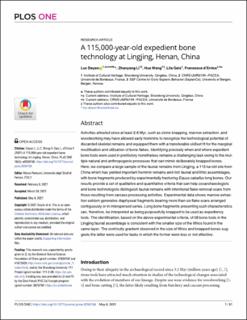| dc.contributor.author | Doyon, Luc | |
| dc.contributor.author | Li, Z | |
| dc.contributor.author | Wang, H | |
| dc.contributor.author | Geis, L | |
| dc.contributor.author | d'Errico, Francesco | |
| dc.date.accessioned | 2022-02-04T09:40:18Z | |
| dc.date.available | 2022-02-04T09:40:18Z | |
| dc.date.created | 2021-09-13T10:03:50Z | |
| dc.date.issued | 2021 | |
| dc.identifier.issn | 1932-6203 | |
| dc.identifier.uri | https://hdl.handle.net/11250/2977097 | |
| dc.description.abstract | Activities attested since at least 2.6 Myr, such as stone knapping, marrow extraction, and woodworking may have allowed early hominins to recognize the technological potential of discarded skeletal remains and equipped them with a transferable skillset fit for the marginal modification and utilization of bone flakes. Identifying precisely when and where expedient bone tools were used in prehistory nonetheless remains a challenging task owing to the multiple natural and anthropogenic processes that can mimic deliberately knapped bones. Here, we compare a large sample of the faunal remains from Lingjing, a 115 ka-old site from China which has yielded important hominin remains and rich faunal and lithic assemblages, with bone fragments produced by experimentally fracturing Equus caballus long bones. Our results provide a set of qualitative and quantitative criteria that can help zooarchaeologists and bone technologists distinguish faunal remains with intentional flake removal scars from those resulting from carcass processing activities. Experimental data shows marrow extraction seldom generates diaphyseal fragments bearing more than six flake scars arranged contiguously or in interspersed series. Long bone fragments presenting such characteristics can, therefore, be interpreted as being purposefully knapped to be used as expediency tools. The identification, based on the above experimental criteria, of 56 bone tools in the Lingjing faunal assemblage is consistent with the smaller size of the lithics found in the same layer. The continuity gradient observed in the size of lithics and knapped bones suggests the latter were used for tasks in which the former were less or not effective. | en_US |
| dc.language.iso | eng | en_US |
| dc.publisher | Public Library of Science | en_US |
| dc.rights | Navngivelse 4.0 Internasjonal | * |
| dc.rights.uri | http://creativecommons.org/licenses/by/4.0/deed.no | * |
| dc.title | A 115,000-year-old expedient bone technology at Lingjing, Henan, China | en_US |
| dc.type | Journal article | en_US |
| dc.type | Peer reviewed | en_US |
| dc.description.version | publishedVersion | en_US |
| dc.rights.holder | Copyright 2021 Doyon et al. | en_US |
| dc.source.articlenumber | e0250156 | en_US |
| cristin.ispublished | true | |
| cristin.fulltext | original | |
| cristin.qualitycode | 1 | |
| dc.identifier.doi | 10.1371/journal.pone.0250156 | |
| dc.identifier.cristin | 1933641 | |
| dc.source.journal | PLOS ONE | en_US |
| dc.relation.project | Norges forskningsråd: 262618 | en_US |
| dc.identifier.citation | PLOS ONE. 2021, 16 (5), e0250156. | en_US |
| dc.source.volume | 16 | en_US |
| dc.source.issue | 5 | en_US |

